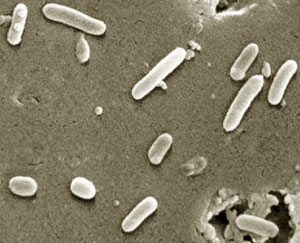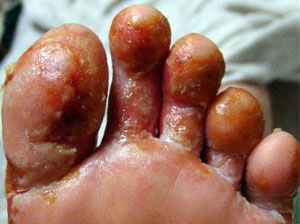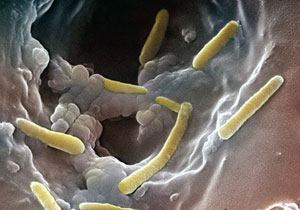|
 |
Pseudomonas Aeruginosa
What is Pseudomonas Aeruginosa

Pseudomonas aeruginosa is a medically important human representatives of the genus Pseudomonas. This is approximately 2-4 mm long, non-spore-forming Gram-negative rods with polar flagellum. Pseudomonas aeruginosa can be attributed to simple culture media cultivate easily. On solid media show is mostly flat, great gray, often slimy-growing colonies, the surface often has a metallic sheen.
Serve as a carbon source Pseudomonas aeruginosa organic compounds, is required for their utilization of molecular oxygen as an electron acceptor. The bacterial counts therefore to obligate aerobes. The optimum temperature is increasing at 36 ° C. Growth is also at 41 ° C, but not possible at 4 ° C. In liquid media, the seed grows to form a so-called scum predominantly at the surface.
Most strains produce pigment under appropriate conditions. The main colors are yellow-green pyoverdin (fluorescein) and the bluish-green pyocyanin. Due to the formation of pigment was Pseudomonas aeruginosa earlier than the blue-green pus bacteria (Bacterium pyocyaneum) refers. The term aeruginosa derived from the Latin word aerugo (verdigris) from.
Pseudomonas Aeruginosa Pathogenesis

Pseudomonas aeruginosa is due to its high resistance and low nutrient demands in the environment is widespread. There he is, especially in damp places, such as in soil and surface water, on plants and fruits as well as in the colon of healthy people to find. When he wet seed can also contaminate many areas and products in the home environment. This includes the plumbing, cleaning supplies, medicines, cosmetics and liquids for storage of contact lenses. But it can also survive in a dry medium for some time. In the hospital put next to the sanitation, contaminated IV solutions and blood products, primarily ventilators and nebulisers, humidifiers, and dialysis equipment and fluids important extracorporeal pathogen reservoir of the high resistance of Pseudomonas aeruginosa also requires that possess some disinfectant insufficient efficacy.
At the hospital, the number of patients who are colonized with Pseudomonas aeruginosa, with the duration of the stay. The settlement takes place preferably on moist skin. In intensive care patients is also often colonized the upper respiratory tract.
The mechanisms of pathogenicity are complex. Virulence factors are fimbriae that mediate adhesion to the cell surface, as well as various enzymes and exotoxins that the bacterium produces. Elastase, and proteases facilitate the invasion, where they are supported by the hemolysins (especially phospholipase C) that cause membrane damage in the tissue cells. Of exotoxin A, probably the most important virulence factor, exoenzyme S and is known to negatively affect the protein.
Pseudomonas aeruginosa is the most common pathogens causing nosocomial infections. According to the Hospital Infection Surveillance System (KISS) in Germany caused approximately 10% of all hospital infections caused by Pseudomonas aeruginosa. In most cases these are pneumonia, skin and wound infections and infections of the urogenital tract. During sepsis, the proportion caused by Pseudomonas aeruginosa, about 3%. The Pseudomonas sepsis is burdened with the highest fatality rate among all forms of sepsis. Other diseases are ecthyma gangrenosum, meningitis, otitis and eye infections.
Pseudomonas aeruginosa infections occur mainly in patients with immune deficiency. Most cases are therefore found in the critical care area, in burn units and hematology-oncology at stations. Drug addicts are also dar. a risk group outside the hospital Pseudomonas aeruginosa plays as a pathogen only in patients with cystic fibrosis, bronchiectasis and a greater role in urological infections.
Pseudomonas Aeruginosa Diagnosis

The microbiological diagnosis involves the isolation of the pathogen from the respective test materials and biochemical identification.
Pseudomonas aeruginosa is naturally resistant to many antibiotics. Those available in Germany only the beta-lactam antibiotics Acylureidopenicilline [piperacillin (PIPRIL) + beta-lactamase inhibitor], aztreonam (AZACTAM), and certain cephalosporins [ceftazidime (Fortum), cefepime (Maxipime)] and carbapenems [imipenem (ZIENAM etc.) meropenem (Meron),] sufficiently effective. A good activity also show the aminoglycosides [amikacin (BIKLIN), gentamicin (Refobacin etc.), netilmicin (CERTOMYCIN), tobramycin (GERNEBCIN)] and fluoroquinolones [(ciprofloxacin (Cipro, etc.), levofloxacin (Tavanic)].
According to the study resistance of the Paul Ehrlich Society for Chemotherapy in 2004 in each case > 90% of the strains were sensitive to meropenem and tobramycin. For amikacin, cefepime, ceftazidime, ciprofloxacin and piperacillin / tazobactam (Tazobac) varied the proportion of sensitive strains between 75% and 80%. It should be noted, however, that the isolates from patients on general wards usually sensitive to antibiotics were significantly more likely than those in intensive care units.
Pseudomonas Aeruginosa Therapy
The calculated treatment of infections where Pseudomonas aeruginosa is suspected as the causative agent, to keep up with the local resistance situation. To treat life-threatening infections are piperacillin / tazobactam, ceftazidime, cefepime, imipenem or meropenem, usually in combination with a Pseudomonas effective aminoglycoside or fluoroquinolone considered. For less severe infections may also be monotherapy with a beta-lactam antibiotic ciprofloxacin or be successful if adequate doses by the development of a resistant subpopulation is prevented. The treatment of Pseudomonas infections in patients with cystic fibrosis based on the antibiogram. If necessary. Macrolides are also due to their immunomodulatory properties for the treatment in question. For the initial treatment of malignant external otitis is piperacillin (12-20 g daily) in combination with tobramycin (0.24 g daily) for four weeks and then oral ciprofloxacin (g daily 1-1.5) over several months recommended.
|
